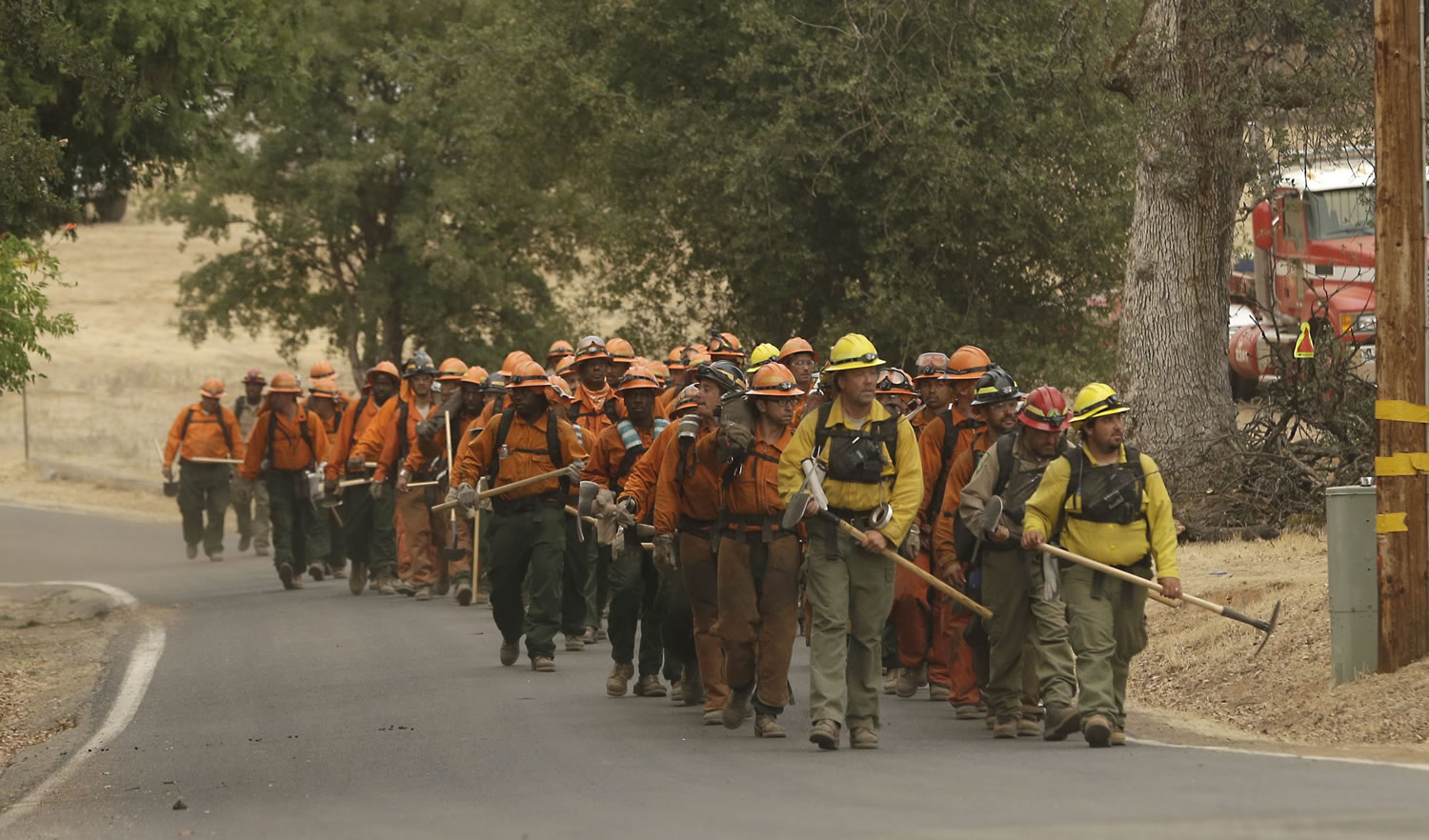The burn area of the Valley fire in Northern California covers more than 100 square miles, and by Tuesday morning, the property toll included 585 homes, as well as many other structures.
Attempting to contain and control the fire in Lake County are some 1,400 personnel from the California Department of Forestry and Fire Protection, state prison camps, community fire departments and wildland firefighters from Colorado.
Most work in 24-hour shifts and only about half are in the field at any time.
Three major wildfires continued to burn out of control Tuesday, and Gov. Jerry Brown warned the previous day that, given the ravages of drought and the growing influence of climate change, “there is more to come.”
By comparison, the similarly sized Butte fire to the east in the Sierra Nevada had nearly 4,600 personnel on it Tuesday morning, including 505 fire engines.
“We have multiple fires, so we’re all stretched thin,” said CalFire’s incident commander for the Valley fire, Robert Michael. “We’re starting to get resources reassigned as each fire is starting to get their containment up . . so we all started short, meaning we’re just stretched.”
Michael said it is not fair to compare the number of crews, trucks and helicopters sent to different fires.
“I don’t know why you need to compare. Each incident is different. They are all equally important,” Michael said. “They lost structures on the Butte fire, they lost structures here.
“They do prioritize incidents but right now because they’re all losing structures, they’re all having extreme fire behavior, they’re all probably equal.”
How the state tasks its fire assets is not just a matter of how many fires, but which ones started first, and “the resources that were assigned initially,” he said.
Michael struggled with the question of why more resources are not being diverted to the Valley fire, with 9,000 homes threatened. The Butte Fire, which remains only 35 percent contained, has 6,400 threatened structures.
“If we have 20 houses burning and we pulled all of the resources off and sent them to another fire that had 100 houses that were threatened, would you as a private citizen appreciate that?” he said.
By the start of Tuesday, 2,300 personnel had joined the effort, including 15 helicopters, a CalFire spokesman said.
Large planes with fire retardant had not worked the Valley fire since its start Saturday. They are expected to join the fray Tuesday, as cloud cover lifted.
“We’ve seen a favorable change in the weather so we’ll be able to engage more aggressively with our air resources today,” said CalFire information officer Mike Smith. “All of our air resources will be dropping water and fire retardant on the lines.”
However, he said, “the vast majority of the perimeter of this fire remains very dangerous.”
In hilly and rural Lake County, a short drive north of the state’s storied wine country, the ferocity and breakaway speed of the Valley fire stunned veteran firefighters, hampered strategic planning and gave rise to worries that it could be a harbinger of an extended, and unpredictable, fire season in the months ahead.
As of Tuesday morning, the still-raging fire had grown to 67,000 acres and was just 15 percent contained.
On Monday, authorities confirmed the death of a woman inside her home. Sheriff’s deputies had found her remains in a charred residence on Cobb Mountain the night before. Officials said there were other individuals unaccounted for.
A seven-mile stretch of Highway 175 connecting Cobb, where the fire originated, to the devastated town of Middletown was a corridor of destruction: blackened, abandoned cars, denuded pine groves, dead animals, gutted houses.
“An extraordinarily hostile fire,” said veteran firefighter Kevin Rosado, who was working near the highway Monday.
Two hundred miles to the east, in Sierra foothill Gold Country, the Butte fire by midday Monday had destroyed 135 homes in Amador and Calaveras counties. Crews had managed to carve out containment lines around a third of the fire, which has placed thousands of residences in peril.
The blaze has scorched through 71,660 acres and was 37 percent contained Tuesday morning.
To the south, the Rough fire burning in the Sequoia National Forest was reported to be 40 percent contained, but it already has devoured 211 square miles and filled the San Joaquin Valley with stifling smoke.
“These are serious fires,” Brown said Monday at the State Office of Emergency Services. “People have been killed. Hundreds of structures have been destroyed. There is more to come.”
Ken Pimlott, director of the California Department of Forestry and Fire Protection, who joined Brown at a news conference, said the state already has experienced 6,000 fires this year – 1,500 more than last year. He added, “We don’t see an end to fire season for months to come.”
As he has previously done this fire season, Brown anecdotally drew a link between the volatility and frequency of recent wildfires to climate change.
“The fires are acting more aggressively, more unpredictably,” he said. “It’s scary stuff. . We are really in a battle with Mother Nature, and nature is more powerful than we are.”
Though researchers generally applaud the governor’s efforts to raise public awareness about climate change, not all are convinced the hard evidence is in yet to scientifically link a summer of intense wildfires with global warming.
“It’s great that he’s using fire to raise that awareness,” said Max Moritz, co-director of the University of California Center for Fire Research and Outreach, “but there are still open questions over how much you can make those links. It’s a tightrope.”
Later in the day, the governor authorized $12.4 million in additional spending to help fight the Lake County and Gold Country fires – and the additional blazes he said were sure to come.
Early morning fog and a thick layer of smoke hugging the rugged terrain Tuesday is expected to delay liftoff for some dozen helicopters waiting outside Lakeport to aid those crews on the ground.




